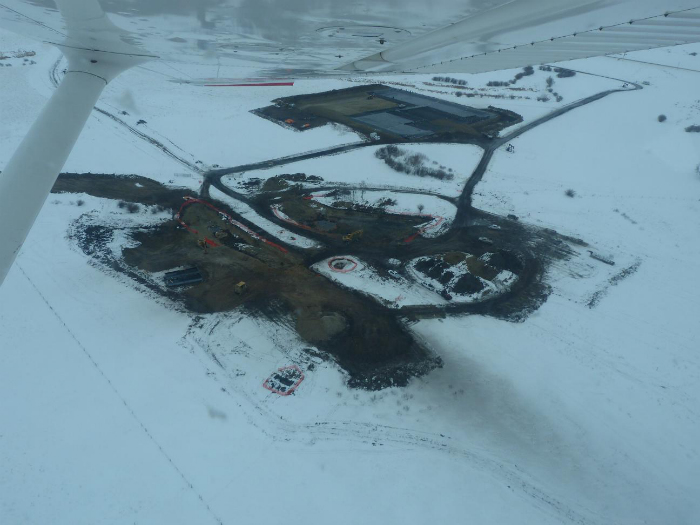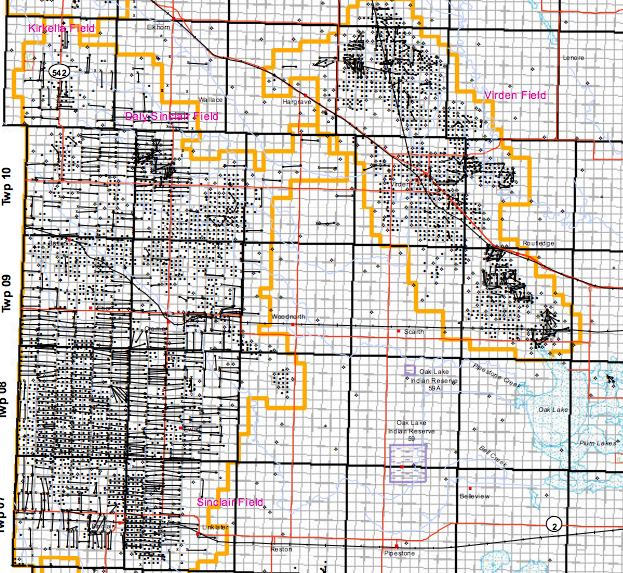Producers frustrated with Manitoba oil industry by Robert Arnason, May 17, 2013, Western Producer
KOLA, Man. — Driving west of Virden, Man., on Highway 257, it’s impossible not to notice the incredible level of activity in Manitoba’s oil patch.
… Carlyle Jorgensen has witnessed the boom in Manitoba’s oil patch over the last decade from his farm seven kilometres south of Kola and less than one km from the Saskatchewan border. Like other parts of North America, horizontal drilling and fracking have opened up the Sinclair Oil Field, Manitoba’s tiny portion of the Bakken deposit that is centered in North Dakota and southeastern Saskatchewan.
The province quadruped oil production from 1999 to 2011 and now produces more than 40,000 barrels per day.
…
However, Jorgensen and dozens of other farmers in the region are now feeling what many Albertans have dealt with for years: frustration over the perception that the oil industry rides roughshod over landowner rights.
Tired of bickering with oil companies about issues on his land, Jorgensen went public last year and began speaking to the media about oil spills and other regulatory violations in Manitoba’s oil patch.
Sitting on a stool in his machine shop, Jorgensen said it was a difficult decision to air his grievances publicly.
“I’m not comfortable one bit about it. These are powerful companies and I’m just a speck on the ground here,” he said.
“But I have no choice. The way I was raised and the way I think … I cannot let this stuff happen on my property or my neighbour’s property and think I’m living life properly.”
In the winter of 2011-12, Jorgensen discovered what appeared to be an intentional spill of oil and salt water in a ditch a few kilometres from his farm. After getting nowhere with the province, Jorgensen spoke about the spill at a Keystone Agricultural Producers meeting in late 2012. This winter an underground flow line from a well broke on his neighbour’s land. An estimated 100,000 litres, more than 600 barrels, leaked out of the pipe and onto the soil. Considering the amount of oil that was involved, Jorgensen thinks the flow line likely leaked for days or weeks before it was detected. During a flight over the site this winter, Jorgensen photographed the spill as bulldozers and other heavy equipment cleaned up the contaminated soil. According to media reports, the spill was one of 47 reported in Manitoba by early April, easily on pace to exceed the 90 spills recorded last year.
However, data on reported spills doesn’t represent the actual number of accidents. “There’s been a whole lot more flow line breaks than what the public is told about,” said Jorgensen, vice-president of the Manitoba Surface Rights Association, which represents 200 landowners in southwestern Manitoba. Lenora Crepeele, who farms near Waskada, Man., agreed the oil industry isn’t transparent when it comes to spills. “I’ve had them (an oil company) come to pay me compensation for a spill that I didn’t even know about,” she said. “There’s been many times where I drive by and see a pile of dirt. I’m like, ‘what the heck’s going on?’ I’ve had to drive back and (they) say, ‘we’ve had a pipeline break’. But they haven’t notified (us) that they had to dig it up.”
Jorgensen said the substantial spill this winter is an example of the lack of oversight when it comes to the oil industry in Manitoba. He said it would be impossible for an underground flow line to leak for days or weeks without anyone noticing if the province required oil companies to check wells for leaks more often and follow certain protocols. “I’m not asking for anything outrageous. When it comes to spills, I don’t think any regulation is too stringent,” he said. “The cost of pressuring a line every two days would be pretty minimal, compared to the amount of money they’re making off of that well. Let’s keep in mind that these (companies) aren’t barely scraping by…. These are wealthy, wealthy companies.” … “You could be buying yourself a whole pile of liability if there is a mass of buried pipe or old flow lines,” said Jorgensen, who has 11 active wells on his land.
Eldon Boon, who farms near Virden, said abandoned pipelines and wells are his principal frustration with the oil industry. He thinks the infrastructure should be removed and the land remediated. “Now that they’ve gone to horizontal (wells), they’ve abandoned some of the old verticals,” he said. “The drilling of new wells, it’s just ongoing. But the reclamation of old well sites, it’s pretty slow. A lot of times (the wells) will sit for years…. I’d really like to see that process speeded up.”
It’s not surprising that Alberta’s regulatory environment is more sophisticated than what’s in place in Manitoba, considering that Alberta produces 2.5 million barrels per day compared to 40,000 barrels in Manitoba. For example, Alberta created a new energy regulator this spring that the government says will be at arm’s length from it and address the social and environmental impacts of the petroleum industry, along with the economic benefits. Some Albertans remain skeptical, but Jorgensen said the regulatory approach is in contrast to Manitoba’s policy. “This province lets the oil companies self regulate.” … He said the government’s petroleum branch, which is supposed to enforce regulations, cannot fulfill that role because it is also in the business of promoting Manitoba’s oil patch. … [Emphasis added]
Manitoba’s dark secret by Toban Dyck, April 12, 2013, Spectator Tribune
Source: Spectator Tribune
[Refer also to:
Over 30 Alberta groups demand oil industry fox Gerard Protti get out of Alberta’s henhouse
The Rainbow Spill: A Case of Crime and No Punishment and Captured Alberta Politicians and Regulators


